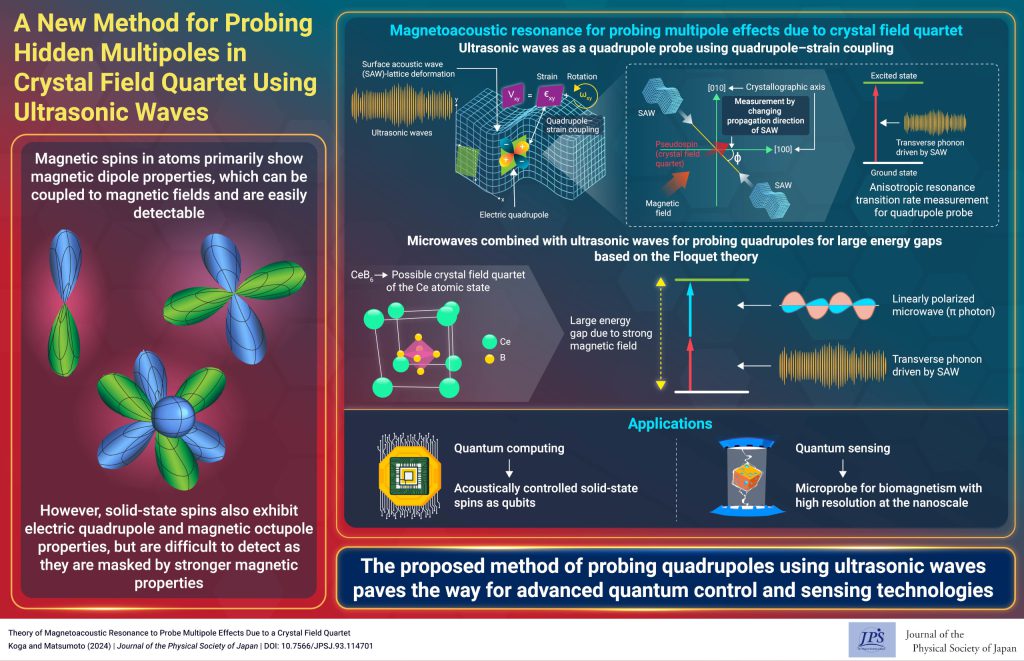A New Method for Probing Hidden Multipoles in Crystal Field Quartet Using Ultrasonic Waves
© The Physical Society of Japan
This article is on
Theory of Magnetoacoustic Resonance to Probe Multipole Effects Due to a Crystal Field Quartet
(JPSJ Editors' Choice)
J. Phys. Soc. Jpn.
93,
114701
(2024)
.
A new method of acoustically driven resonance is proposed to unveil the multipole degrees of freedom of a crystal-field quartet and demonstrate the realization of spin acoustic control.

Magnetic atoms primarily exhibit the properties of magnetic dipoles. In addition to magnetic dipoles general, solid-state spins have electric quadrupoles and magnetic octupoles known as typical multipole degrees of freedom. Magnetic dipoles can be coupled to a magnetic field and are easily detectable. However, directly observing the characteristics of multipoles is challenging because of the practical limitations of external fields coupled with multipoles. Because a quadrupole can be coupled to strain fields induced by lattice deformations, we present a new magnetoacoustic resonance method for analyzing the multipoles of solid-state spins using an ultrasonic wave propagating on the surface layer of the lattice. Recent developments in acoustic measurements have increased the importance of fundamental theory for the direct observation of quadrupole characteristics using magnetoacoustic resonance.
In this study, we focus on the rich multipole physics of CeB6, which may have originated from a crystal-field quartet of the Ce atomic state. A method to directly analyze multipoles is desirable. Ce quadrupoles can be coupled to strain fields driven by ultrasonic waves, and CeB6 is a favorable candidate for testing our method. Using solely ultrasonic waves renders it difficult to realize high-frequency measurements, which are necessary in the case of CeB6, owing to technical limitations arising from the increase in frequency. This challenging problem can be solved by combining acoustic and optical measurements, i.e., using microwaves with ultrasonic waves simultaneously, because the microwave frequencies can be increased sufficiently for experiments under relatively high magnetic fields. This method is inspired by the analogy of two-photon absorption transition using electromagnetic waves with two different frequencies.
Our method of using quadrupoles coupled with ultrasonic waves may result in the use of acoustically operating solid-state spins as qubits for quantum computers and can be used in various applications of quantum information technology. Additionally, this innovation in acoustic control may complement conventional methods of optical control. Another important application is quantum sensing, such as biomagnetism microprobes with high resolution at the nanoscale.
(Written by Mikito Koga on behalf of all authors)
Theory of Magnetoacoustic Resonance to Probe Multipole Effects Due to a Crystal Field Quartet
(JPSJ Editors' Choice)
J. Phys. Soc. Jpn.
93,
114701
(2024)
.
Share this topic
Fields
Related Articles
-
Higher-Order Topological Phases in Magnetic Materials with Breathing Pyrochlore Structures
Electronic structure and electrical properties of surfaces and nanostructures
Magnetic properties in condensed matter
Mathematical methods, classical and quantum physics, relativity, gravitation, numerical simulation, computational modeling
2025-4-7
A simple example of a higher-order topological phase, in which the symmetry decreases step-by-step from the bulk to the corner, is realized in a magnetic system with a pyrochlore structure and is characterized by a series of quantized Berry phases defined for the bulk, surface, and edge.
-
Existence of Chiral Soliton Lattices (CSLs) in Chiral Helimagnet Yb(Ni1-xCux)3Al9
Magnetic properties in condensed matter
2025-4-1
Our study examines the magnetic structure of the monoaxial chiral helimagnet Yb(Ni1-xCux)3Al9, providing first direct evidence of the formation of chiral soliton lattice state.
-
Understanding Pressure-Induced Superconductivity in CrAs and MnP
Magnetic properties in condensed matter
2025-3-10
This study reviews existing research on the pressure-induced variation of magnetic properties of transition metal mono-pnictides like CrAS, MnP, and others, aiming to understand the unconventional superconductivity observed in CrAs and MnP.
-
Symmetry and AI: Building the Future of Physics Simulations
Magnetic properties in condensed matter
Measurement, instrumentation, and techniques
2025-2-18
Generative artificial intelligence (AI) has gained considerable attention in scientific fields. By embedding physical symmetry into AI before training, we created a faster and lighter model. Scaling improves the accuracy and unlocks the potential of physics research and applications.
-
Triangular Lattice Magnet GdGa2: Spin Cycloids and Skyrmions
Cross-disciplinary physics and related areas of science and technology
Electronic transport in condensed matter
Magnetic properties in condensed matter
2025-2-3
Careful measurements were conducted on the hexagonal magnet GdGa2 to reveal the experimental signatures of ultrasmall spin cycloids and of a potential Néel-type skyrmion lattice phase induced by a magnetic field.




